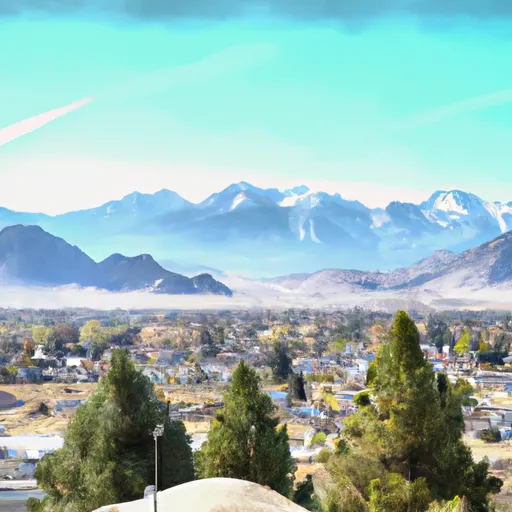-
 Snoflo Premium
Snoflo Premium
Get unlimited access to all our content
With no Ad interruptions! - Start Your Free Trial Login with existing account
Lone-Pine
Eden Index
Climate
8.2
•
Recreation
6.3
•
Community
1.5
•
Safeguard
5.9/10

Lone Pine, California is a small town located in the Owens Valley, nestled between the towering Sierra Nevada Mountains and the Inyo Mountains. The town enjoys a dry climate with hot summers and mild winters. Summers are characterized by highs in the 90s Fahrenheit, while winters see temperatures in the 40s and 50s. The region receives low precipitation, averaging just 5 inches annually, primarily in the form of snow during the winter months.
The hydrology constituents in Lone Pine are heavily influenced by the nearby Sierra Nevada Mountains. The town is situated near the Owens River and is close to numerous lakes and streams, providing ample opportunities for fishing, boating, and other water activities. Additionally, Lone Pine is near the Alabama Hills, a unique rock formation that attracts rock climbers, hikers, and photographers. The nearby Mount Whitney, the highest peak in the contiguous United States, offers challenging hiking and mountaineering adventures. The area also serves as a gateway to the stunning landscapes of Death Valley National Park, making Lone Pine an ideal base for exploring the diverse outdoor recreation opportunities in the region.
What is the Eden Index?
The Snoflo Eden Index serves as a comprehensive rating system for regions, evaluating their desirability through a holistic assessment of climate health, outdoor recreation opportunities, and natural disaster risk, acknowledging the profound impact of these factors on livability and well-being.
Climate Health Indicator (CHI): 8.2
Lone-Pine receives approximately
162mm of rain per year,
with humidity levels near 36%
and air temperatures averaging around
16°C.
Lone-Pine has a plant hardyness factor of
8, meaning
plants and agriculture in this region tend to thrive here all year round.
By considering the ideal temperature range, reliable water supplies, clean air, and stable seasonal rain or snowpacks, the Climate Health Indicator (CHI) underscores the significance of a healthy climate as the foundation for quality living.
A healthy climate is paramount for ensuring a high quality of life and livability in a region, fostering both physical well-being and environmental harmony. This can be characterized by ideal temperatures, reliable access to water supplies, clean air, and consistent seasonal rain or snowpacks.
Weather Forecast
Streamflow Conditions
Mono-Owens Lakes
Area Rivers
Mono-Owens Lakes
Snowpack Depths
Mono-Owens Lakes
Reservoir Storage Capacity
Mono-Owens Lakes
Groundwater Levels
Recreational Opportunity Index (ROI): 6.3
The Recreational Opportunity Index (ROI) recognizes the value of outdoor recreational options, such as parks, hiking trails, camping sites, and fishing spots, while acknowledging that climate plays a pivotal role in ensuring the comfort and consistency of these experiences.
Access to outdoor recreational opportunities, encompassing activities such as parks, hiking, camping, and fishing, is crucial for overall well-being, and the climate plays a pivotal role in enabling and enhancing these experiences, ensuring that individuals can engage in nature-based activities comfortably and consistently.
Camping Areas
| Campground | Campsites | Reservations | Toilets | Showers | Elevation |
|---|---|---|---|---|---|
| Alabama Hills Dispersed | None | 4,603 ft | |||
| Diaz Lake | 200 | 3,683 ft | |||
| Symmes Creek | None | 5,143 ft | |||
| Portagee Joe | 15 | 3,780 ft | |||
| Independence Creek | 25 | 4,038 ft | |||
| Tuttle Creek | 85 | 5,124 ft | |||
| Goodale Creek | 62 | 4,083 ft | |||
| Whitney Portal | 43 | 7,928 ft | |||
| Lone Pine | 42 | 5,866 ft | |||
| Grays Meadow | 52 | 5,852 ft |
Nearby Ski Areas
Catastrophe Safeguard Index (CSI):
The Catastrophe Safeguard Index (CSI) recognizes that natural disaster risk, encompassing floods, fires, hurricanes, and tornadoes, can drastically affect safety and the overall appeal of an area.
The level of natural disaster risk in a region significantly affects safety and the overall livability, with climate change amplifying these risks by potentially increasing the frequency and intensity of events like floods, fires, hurricanes, and tornadoes, thereby posing substantial challenges to community resilience and well-being.
Community Resilience Indicator (CRI): 1.5
The Community Resilience Indicator (CRI) recognizes that education, healthcare, and socioeconomics are crucial to the well-being of a region. The CRI acknowledges the profound impact of these elements on residents' overall quality of life. By evaluating educational resources, healthcare accessibility, and economic inclusivity, the index captures the essential aspects that contribute to a thriving community, fostering resident satisfaction, equity, and social cohesion.

